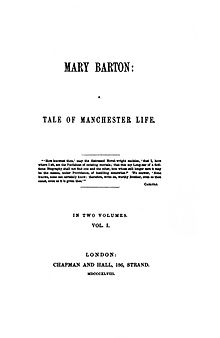 Title: Mary Barton
Title: Mary Barton
Author: Elizabeth Gaskell
Date of First Publication: 1848
Place of Publication: Chapman & Hall
Type: Novel
Keywords: SYMPATHETIC MONSTER; RACE/POLITICS
Critical Summary: A “condition of England” (a term from Carlyle) novel or “social problem novel,” Mary Barton is published in 1848, a year of revolutions across Europe. Though England does not revolt, the working classes are suffering and restless at the time of publication. Manchester, where the novel is set, has been an engine of the Industrial Revolution, but a downturn drives great numbers out of work and into dire poverty in the “hungry forties.” The Chartist movement, presenting demands from the working class for fair treatment, is considered radical. Mary Barton is a poor working class girl; her mother dies and her father, John Barton, a mill worker in the textile factories, is part of the Trade Unions and the Chartist movement. While Mary proceeds through various romantic entanglements, John goes to London to deliver Chartist demands, but nothing comes from it. As his family dies of starvation, he devolves into opium and assassination of a man from the ruling class who had been his friend but, after a rise in power, persecuted him and his “radical” ideas; Mary, with her true love, emigrates to Canada.
Frankenstein is directly referred to in Chapter XV, where Gaskell compares John Barton to Frankenstein’s monster (calling him a “Frankenstein” in the common confusion of the Creator and Created). Gaskell sees the lower classes as made into monsters by their condition and the indifference of the ruling class to the reasons for their anger and “radical” demands for fair treatment. Gaskell would have the ruling class care, in a Dickensian Scrooge mode, in order to reunify England; she has sympathy for the condition of the working class, but abhors the radical ideas of the Chartists as lacking Christian resignation to our lot in life.
Administrative Notes: Dr. David Sandner, CSUF
